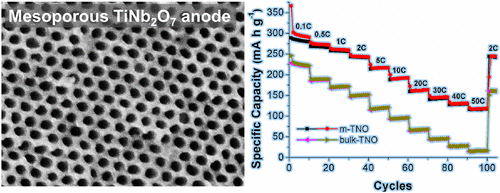Block CopolymerDirected Ordered Mesostructured TiNb2O7 Multimetallic Oxide Constructed of Nanocrystals as High Power Li-ionBattery Anodes
- Journal
- Chemistry of Materials
- Vol
- 26
- Page
- 3508-3514
- Year
- 2014
- Link
- https://pubs.acs.org/doi/10.1021/cm501011d 568회 연결
In order to achieve high-power and -energy anodes operating above 1.0 V (vs Li/Li+), titanium-based materials have been investigated for a long time. However, theoretically low lithium charge capacities of titanium-anodes have required new types of high-capacity anode materials. As a candidate, TiNb2O7 has attracted much attention due to the high theoretical capacity of 387.6 mA h g–1. However, the high formation temperature of the TiNb2O7 phase resulted in large-sized TiNb2O7 crystals, thus resulting in poor rate capability. Herein, ordered mesoporous TiNb2O7 (denoted as m-TNO) was synthesized by block copolymer assisted self-assembly, and the resulting binary metal oxide was applied as an anode in a lithium ion battery. The nanocrystals (∼15 nm) developed inside the confined pore walls and large pores (∼40 nm) of m-TNO resulted in a short diffusion length for lithium ions/electrons and fast penetration of electrolyte. As a stable anode, the m-TNO electrode exhibited a high capacity of 289 mA h g–1 (at 0.1 C) and an excellent rate performance of 162 mA h g–1 at 20 C and 116 mA h g–1 at 50 C (= 19.35 A g–1) within a potential range of 1.0–3.0 V (vs Li/Li+), which clearly surpasses other Ti-and Nb-based anode materials (TiO2, Li4Ti5O12, Nb2O5, etc.) and previously reported TiNb2O7 materials. The m-TNO and carbon coated m-TNO electrodes also demonstrated stable cycle performances of 48 and 81% retention during 2,000 cycles at 10 C rate, respectively.

